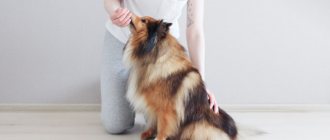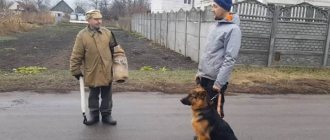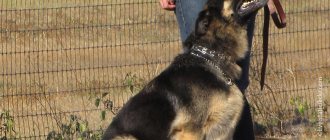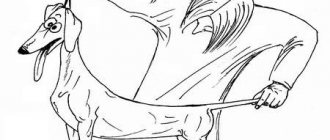Training is a troublesome, but mandatory task for every pet owner. How to teach a dog the “down” , where to start training, what training methods exist - everything is detailed in one article.
We recommend that you read important articles on the topic:
- How to train a dog: tips, rules, methods;
- Puppy training: effective methods from dog trainers, learning commands at home;
- How to properly train German Shepherd puppies: basic education from a dog trainer.
Why is the “Down” command needed?
Even though the “Down” command is not used very often, every well-mannered dog should know it. The “Down” command for a puppy is considered one of the basic ones, and most breeds learn it quite quickly. Where can it be useful?
In everyday life
The skill of lying down on command will be useful for you and your pet on public transport, for example, on the train. In any situation where the dog must stop activity, this skill is appropriate: at an exhibition, hunting, examination by a veterinarian, etc. In addition, the “Lie Down” command is included in all disciplinary training courses and in almost all dog sports disciplines.
Laying the dog down helps to fix it in a calm position and, if necessary, leave the dog in this position for a certain time. This will make grooming, nail trimming, teeth brushing, combing and other hygiene procedures easier.
Standard
Performing at an exhibition or competition involves demonstrating commands, and if the plan is to win awards, then obedience is key. This team is included in all training course standards. The positioning is used to more confidently hold the dog when practicing discipline in the “Exposure” technique.
Features of raising a dachshund
Rules for raising dachshunds:
- Dachshunds are stubborn dogs, so you will need to be patient before training them. It usually takes two to five days to study one command.
- Usually, training puppies requires a lot of persistence, because they behave like children: they play pranks, do not calm down, and sometimes even bite.
- When raising a pet, you need to pronounce commands loudly and clearly, without adding unnecessary words.
- When pronouncing the taxi's name, there is no need to do so in a rude, abusive tone.
- Violence and cruelty should never be used as punishment. The restless person is punished with such orders as “Place”, “No”, etc.
When to start classes
It is better to start training when your pet is three months old. It is important that the puppy clearly understands who his owner is and obeys only him. Therefore, at an early age, it is not recommended for the baby to have close contact with strangers, treats from strangers, or play with anyone other than the owner.
As with learning the commands “Sit!” and “Stop!”, food motivation or skill development using a contrasting method (coercion + encouragement) is used. Compulsion - pressing on the withers or hooking, encouragement - a tasty reward, praise.
If training is successful, the pet should quickly lay down from a standing position. Representatives of decorative breeds and melancholic pets are recommended to master the skill of styling after mastering the “Sit!” command.
The main mistakes that dog owners make during the training process
Proper training makes control easier.
Alas, novice breeders quite often make mistakes. At first glance, they are insignificant, but it is because of them that training is delayed and becomes less effective. And it doesn’t matter who you have to work with - a Yorkshire terrier or an Alabai.
It is important that the dog understands what is required of him and wants to carry out the owner’s command. So, here are some mistakes to keep in mind:
- You cannot issue a command several times in a row. It should sound once, but in a firm voice - it is important to show unconditional dominance over the dog, otherwise it simply will not obey - this is the law of the pack.
- You can't misrepresent the command. For example, by saying “Lie down” once, and “Lie down”, “Lie down” or “Lie down already!” at other times, the owner unwittingly knocks down the dog. She doesn't understand that all these commands mean the same thing. Therefore, he cannot respond adequately.
- You cannot simultaneously train several commands, for example, “Sit”, “Lie down”, “Voice”, “Give me a paw”. First, the dog must firmly learn one, and only then, after a quick test of knowledge, move on to the next.
Basic recommendations and rules
Self-training will require certain training from the dog owner. You need to feel the determination to take responsibility for an animal that will trust you unconditionally. Do not forget that the main principle of any training is systematicity and consistency.
You cannot punish or scold your pet: training should take place in a friendly environment. A person should be a leader, not a despot. During training, the dog not only masters the skill, but also becomes attached to the person, learns to listen and respect him.
The training process is built consistently and correctly from the very beginning, otherwise you will have to retrain the pet later, which is much more difficult. It is important that the dog understands that it is required not just to lie down, but to remain in a lying position until a new command is received from the owner.
It is necessary to choose the right place and time for training. The dog should feel good, rested and moderately hungry. A well-fed animal perceives information worse.
Do not practice for too long - 10-15 minutes is enough to start. Take a break and then repeat what you have learned. Remember the command regularly throughout the training period - otherwise the young dog will lose the skill.
Training will be more successful if you take the advice of experienced dog handlers. The most important of them:
- If a student gets up without the owner’s permission, he must be forced to lie down and repeat the order “Lie down!”
- The exposure time should be increased gradually and slowly.
- The main thing is not quantity, but quality. If you repeat the exercise 10 times in 10 minutes, it is unlikely to give a good result. It is better to perform the exercise once, but at the same time carefully monitor the quality of its execution, the correct position of the pet, and its endurance.
- You need to release the dog with the command “Walk!”, and not “Come to me!”.
Comprehensive training of obstinate and aggressive breeds is recommended - the basis of the courses. During classes, the trainer helps the animal and the owner find the right interaction and disciplines both of them.
Briefly about the main thing
- Start the lesson in a quiet and calm place that the dog is already accustomed to.
- Use treats to guide your dog into a lying position. Don't get angry if your pet doesn't understand the task right away. Have patience.
- After the dog lies down, praise it and give it a treat. Repeat this several times, then enter the voice command.
- Once the dog has mastered the skill, gradually complicate the task: smoothly remove your hand from the dog’s nose, introducing the gesture.
- Start training your endurance. Praise your pet first for being in the “lying” position for a few seconds, gradually increasing the time to several minutes. You can begin to move away from your pet, gradually increasing your steps.
We hope this article will help you in training your pet. You can share your training experience or ask a question. We wish you good luck in raising your tailed ones!
What is needed for training
Before you start learning something new, you need to prepare everything you need. This is not difficult, since you will need the most common devices:
- Comfortable collar
. This is a mandatory item - it is used to control the pet.
- Short leash
(2 m). It will be needed not only for classes, but also for moving to the training site.
- Reward
. This is usually a treat. But do not take regular food - it will not interest the dog and will not become a motivator. Tasty pieces should not be too large, otherwise the dog will quickly get full and lose interest in activities.
- Good mood
. A very important factor, since dogs sense the emotional mood of the owner very well. Only in a calm, friendly environment can a positive result be achieved.
If you're exercising outdoors, bring a couple of toys to keep your dog entertained after the workout.
How to train an adult dachshund at home?
Small dachshunds are often trained through play, but adult dogs will require a different approach. Raising an adult dachshund at 1 year old is not easy, but it is possible. The following two methods of influence in home training are used: reward and punishment.
Methods of encouragement:
- verbal praise and patting at the same time;
- treat with a treat. However, this method should only be used during training;
- stroking (but not on the head).
Methods of punishment during training can be as follows:
- Verbal. Strictly and clearly tell the four-legged “No.” But you don’t need to use his nickname during this, so as not to form a false association of your name with something bad.
- Light shaking. If the dog does not obey at all, you need to take it by the collar and shake it slightly, then release it. Under no circumstances should you choke, beat or abuse your pet.
- Termination of classes. If you lose control of your pet, you need to temporarily stop training.
Where to conduct classes
The “Down” command does not pose any serious physical or mental difficulties for the dog. Therefore, you can start training as soon as your four-legged friend arrives to you and gets used to his new home.
You can train both at home and outside. The main thing is to choose a calm and quiet place where the dog will not be distracted by extraneous sounds or other animals.
The place should be clean, protected from drafts and warm. Because lying on a dirty and damp surface will be unpleasant for the animal. It is better to choose dry soil or any room.
To carry out the “Lie down” command, the pet will not need to move much: on the contrary, it will only sit and lie, so it should not freeze. Most owners teach the dog the skill of grooming within the walls of his home.
Let's sum it up
The “lie down” command, although it seems useless at first, will very soon demonstrate to you all the delights of the fact that the dog knows how to perform it, especially if you always take your dog everywhere and, for example, prefer to travel by public transport. Rest assured that your pet does not suffer from learning commands, but, on the contrary, is happy to learn them, since intellectual exercise develops dogs in almost the same way as humans, and gives them pleasure in the same way.
How to teach your dog the “Down” command
To introduce your dog to the command “Down!” Several methods are used. You need to choose one of them and stick to it until graduation. Treat training is great for puppies, while strength training is great for adult dogs.
With a treat
The simplest and most effective method. Exceptions are dogs whose character pushes them to perform actions not for a treat, but for fun.
How do training sessions with treats work:
- The trainer holds the leash in his hands, the dog is on his left side.
- You need to show your pet a treat and get him interested. Then you should clearly say “Lie down!” and slowly move the hand with the reward forward and down so that the dog reaches for the hand.
- The dog is held by a leash at all times and remains in place. By moving its head towards the treat, the pet will begin to gradually lower itself and take a semi-lying position.
- Press slightly on the withers so that the pet finally lies down. When he is in the desired position, say “Okay!” and give the reward.
- It is important that the dog receives and eats the treat while lying down. If he got up earlier, repeat the manipulation.
- During the first lessons, you can hold your pet in a lying position for 5 seconds, and then give the command “Walk!” (if it is already known).
The skill needs to be practiced. Repeat the exercise several times, alternating between exercises and rest breaks. If you are training outdoors, return home and try to repeat the trick in your own home - so that the “university” of the command is established in the animal.
No treats
This method involves the use of a leash. It is designed for animals that know the “Down” command, but are reluctant to perform it. This is also an excellent method for consolidating a skill. Teaching a dog the “Lie down” command according to this method goes like this:
- Put a leash on your pet.
- Place one hand on the dog's withers and grab the leash with the other.
- Start simultaneously pressing on the withers and pulling the leash down and forward at the same time.
Be careful: do not jerk your pet and make sure that it does not fall over on its side and that its paws are gently stretched forward. This is necessary so that the pet does not get injured.
With hook
You can try to carry out training without treats - the method is suitable for obstinate or adult individuals. In this case, the trainer’s left hand is located on the dog’s withers, and the right hand picks up the pet under the front paws.
After giving the command, you need to gently press on the withers and with your right hand, slightly knocking (hook), move the front paws forward. When the dog takes a lying position, it should be praised and rewarded. After a five-second stay in a lying position, the dog is released with the command “Walk!”
It is important to immediately correct the dog's position when it follows the command. The body should be positioned in a straight line, without falling to the side. The front legs are extended forward, the hind legs are tucked in.
With a gesture
When the pet begins to follow the command well, it is worth adding gestures to the word “Lie down”. Over time, the animal will learn to perform an action by gesture, without words. The "down" command for dogs looks like this:
- the right arm is raised horizontally;
- palm facing up;
- to execute the command, the hand is lowered to the right thigh (at this time the dog should lower itself in unison with the hand).
Breeds that respond well to training can be initially taught to lay with voice and gesture, later leaving only the gesture.
Typical trainer mistakes
To teach your dog commands (including Down), you should avoid the following common mistakes.
- Indifference to training sessions, work without reward with a walk or play, strict adherence to a template training program.
- Inattentiveness of the trainer at moments when the dog exhibits innate tendencies. Incorrect or untimely reward, when, for example, a dog barks at a passing person or animal or tries to grab a bird.
- Poor command technique by the trainer: violation of the rules of uniformity, unclear voice commands, inconsistent gestures and signals. In such cases, the dog’s process of developing a conditioned reflex is disrupted, and it may also become frightened.
- Unclear command delivery, replacement of the command with another consonant word: “sit down!”, “sit down!” instead of “sit!”
- Careless handling of the animal during training: accidental blows with a carabiner or leash, stepping on paws, improper use of training equipment.
- Poor knowledge of the dog’s character and, accordingly, the reasons why the animal refuses to obey commands (including the command to Lie down). Lack of awareness regarding physiology and behavior.
- Assessing a dog’s behavior as if it were a person (humanizing the dog) is the most common and serious mistake made by a novice trainer, trainer or ordinary dog lover.
- Incorrect development of an acquired reflex in a dog, inability to use conditioned and unconditioned stimuli, untimely reinforcement.
What sports are played with dachshunds?
Dachshunds are hardy dogs, and their small size and ability to run quickly help the four-legged dog to easily cover huge distances. Therefore, they engage in various sports with their pet, which include:
- assistance while cycling;
- classes in the pool. Water sports help keep your pet's muscles and joints healthy;
- If your child likes to chase other animals, coursing is suitable for him. This is a kind of sports game where the dog must track down the animal;
- Flyball. This is a team sport where four dogs take turns running a hurdle course, at the end they grab a ball and run back;
- Various competitive sports are also suitable.











